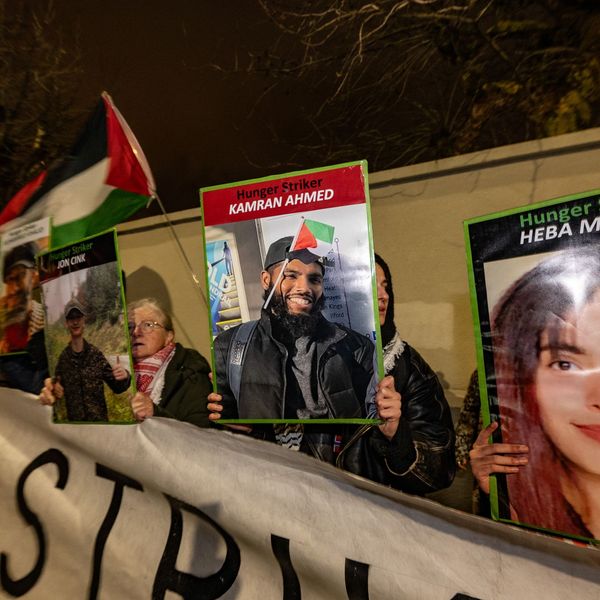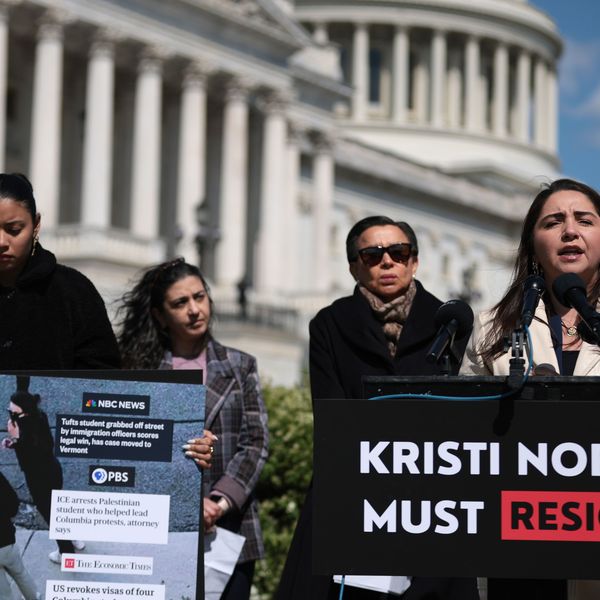
There have been over 2,000 confirmed cases of COVID-19 in ICE detention. (Photo: Erik McGregor/LightRocket via Getty Images)
Listen to the Brave Hunger Strikers in ICE Detention
These strikes are not isolated events, but thoughtful and organized forms of resistance that demonstrate the life and death risks one faces in detention.
Dozens of immigrants detained at Mesa Verde Detention Center in California went on a hunger strike last weekend in solidarity with protesters in San Quentin and to call for their immediate release from detention as the threat of COVID-19 grows. Last month, they also held the first known Black Lives Matter protest inside an ICE detention center to call out the United States's racist incarceration system that terrorizes and criminalizes Black people and people of color.
These hunger strikes at Mesa Verde are two of over 30 hunger strikes that have occurred across the United States in Immigration and Customs Enforcement (ICE) detention during the pandemic. Since March 2020, nearly 2,500 people have joined in on COVID-19-related hunger strikes in detention centers nationwide. That's a massive surge. From 2015-2019, an estimated 1,600 people total participated in hunger strikes in ICE detention.
We cannot ignore how intricately the militarization of police and the criminal legal system are tied to expansions of ICE and Customs and Border Protection (CBP) over the past decade. We also cannot ignore that national protests to defund this system of criminalization are on the rise in the middle of a pandemic that is disproportionately impacting Black people and people of color, and spreading rapidly through prisons and detention facilities where social distancing is impossible.
COVID-19 has exacerbated the catastrophe of ICE detention--a system well-known for widespread abuse, fatal medical neglect, horrific conditions, and a lack of due process rights.
It should not be the case that people have to risk their lives -- hunger weakens the immune system -- to call attention to the emergency they face being trapped in immigration detention during a global pandemic. Yet, more than two months into this crisis, little has changed. We need to release people from incarceration -- including immigrant detention -- now, or "#FreeThemAll" as the grassroots effort calls for. The risks people face while on a hunger strike are greater than ever before, and yet they persist, because their lives are on the line.
COVID-19 has exacerbated the catastrophe of ICE detention--a system well-known for widespread abuse, fatal medical neglect, horrific conditions, and a lack of due process rights.
Advocates and public health experts alike have called for the release of all people in detention as a public health emergency. But months into this crisis, over 24,041 people are still in detention. People in detention fear for their lives and are bravely speaking out and protesting in one of the few ways that they can: refusing meals.
In a pandemic, the health risks of a hunger strike are even greater. There have been over 2,000 confirmed cases of COVID-19 in ICE detention. Lack of food weakens immune systems, making people more susceptible to contracting the deadly virus.
In addition to the health implications, participating in a hunger strike puts people at a greater risk of being retaliated against by ICE, which has a known history of lying and actively hiding information from the public while insidiously retaliating against protesters demanding protection of their health and safety. The violence and swiftness with which retaliation occurs has only increased under the Trump administration.
People in detention who participate in acts of resistance often face abusive treatment from ICE officers in the forms of solitary confinement, force-feeding, denial of due process rights, and fatal medical neglect. Two men who participated in a hunger strike at the La Salle Detention Center in Louisiana reported forced feeding through a nasogastric tube, and were subjected to intravenous hydration during their protest. One of these men also reported that guards refused to allow him to buy an envelope to mail something to his lawyer.
ICE is also known to use rubber bullets, pepper spray and brute force to harass, intimidate and subdue any organizing inside detention centers.During the pandemic, ICE has used various toxic chemicals on people detained, including a disinfectant called HDQ Neutral, that has caused bleeding, burns and pain for people in detention. In May, people at Stewart Detention Center in Georgia protested against the facility's medical negligence in the face of COVID-19 by placing sheets on windows and doors. Guards responded to these protests with pepper spray, gas and throwing people onto the floor. On social media, the guards gloated their abuse, and nothing was done to address the protesters concerns.
These strikes are not isolated events, but thoughtful and organized forms of resistance that demonstrate the life and death risks one faces in detention. They are bold acts of solidarity and commitment that people in detention hold with one another to call for their collective freedom, and collective justice.
They do so because stakes have never been higher and the evidence could not be more clear: we must release every person from ICE detention now. If we don't, people will continue to die.
An Urgent Message From Our Co-Founder
Dear Common Dreams reader, The U.S. is on a fast track to authoritarianism like nothing I've ever seen. Meanwhile, corporate news outlets are utterly capitulating to Trump, twisting their coverage to avoid drawing his ire while lining up to stuff cash in his pockets. That's why I believe that Common Dreams is doing the best and most consequential reporting that we've ever done. Our small but mighty team is a progressive reporting powerhouse, covering the news every day that the corporate media never will. Our mission has always been simple: To inform. To inspire. And to ignite change for the common good. Now here's the key piece that I want all our readers to understand: None of this would be possible without your financial support. That's not just some fundraising cliche. It's the absolute and literal truth. We don't accept corporate advertising and never will. We don't have a paywall because we don't think people should be blocked from critical news based on their ability to pay. Everything we do is funded by the donations of readers like you. Will you donate now to help power the nonprofit, independent reporting of Common Dreams? Thank you for being a vital member of our community. Together, we can keep independent journalism alive when it’s needed most. - Craig Brown, Co-founder |
Dozens of immigrants detained at Mesa Verde Detention Center in California went on a hunger strike last weekend in solidarity with protesters in San Quentin and to call for their immediate release from detention as the threat of COVID-19 grows. Last month, they also held the first known Black Lives Matter protest inside an ICE detention center to call out the United States's racist incarceration system that terrorizes and criminalizes Black people and people of color.
These hunger strikes at Mesa Verde are two of over 30 hunger strikes that have occurred across the United States in Immigration and Customs Enforcement (ICE) detention during the pandemic. Since March 2020, nearly 2,500 people have joined in on COVID-19-related hunger strikes in detention centers nationwide. That's a massive surge. From 2015-2019, an estimated 1,600 people total participated in hunger strikes in ICE detention.
We cannot ignore how intricately the militarization of police and the criminal legal system are tied to expansions of ICE and Customs and Border Protection (CBP) over the past decade. We also cannot ignore that national protests to defund this system of criminalization are on the rise in the middle of a pandemic that is disproportionately impacting Black people and people of color, and spreading rapidly through prisons and detention facilities where social distancing is impossible.
COVID-19 has exacerbated the catastrophe of ICE detention--a system well-known for widespread abuse, fatal medical neglect, horrific conditions, and a lack of due process rights.
It should not be the case that people have to risk their lives -- hunger weakens the immune system -- to call attention to the emergency they face being trapped in immigration detention during a global pandemic. Yet, more than two months into this crisis, little has changed. We need to release people from incarceration -- including immigrant detention -- now, or "#FreeThemAll" as the grassroots effort calls for. The risks people face while on a hunger strike are greater than ever before, and yet they persist, because their lives are on the line.
COVID-19 has exacerbated the catastrophe of ICE detention--a system well-known for widespread abuse, fatal medical neglect, horrific conditions, and a lack of due process rights.
Advocates and public health experts alike have called for the release of all people in detention as a public health emergency. But months into this crisis, over 24,041 people are still in detention. People in detention fear for their lives and are bravely speaking out and protesting in one of the few ways that they can: refusing meals.
In a pandemic, the health risks of a hunger strike are even greater. There have been over 2,000 confirmed cases of COVID-19 in ICE detention. Lack of food weakens immune systems, making people more susceptible to contracting the deadly virus.
In addition to the health implications, participating in a hunger strike puts people at a greater risk of being retaliated against by ICE, which has a known history of lying and actively hiding information from the public while insidiously retaliating against protesters demanding protection of their health and safety. The violence and swiftness with which retaliation occurs has only increased under the Trump administration.
People in detention who participate in acts of resistance often face abusive treatment from ICE officers in the forms of solitary confinement, force-feeding, denial of due process rights, and fatal medical neglect. Two men who participated in a hunger strike at the La Salle Detention Center in Louisiana reported forced feeding through a nasogastric tube, and were subjected to intravenous hydration during their protest. One of these men also reported that guards refused to allow him to buy an envelope to mail something to his lawyer.
ICE is also known to use rubber bullets, pepper spray and brute force to harass, intimidate and subdue any organizing inside detention centers.During the pandemic, ICE has used various toxic chemicals on people detained, including a disinfectant called HDQ Neutral, that has caused bleeding, burns and pain for people in detention. In May, people at Stewart Detention Center in Georgia protested against the facility's medical negligence in the face of COVID-19 by placing sheets on windows and doors. Guards responded to these protests with pepper spray, gas and throwing people onto the floor. On social media, the guards gloated their abuse, and nothing was done to address the protesters concerns.
These strikes are not isolated events, but thoughtful and organized forms of resistance that demonstrate the life and death risks one faces in detention. They are bold acts of solidarity and commitment that people in detention hold with one another to call for their collective freedom, and collective justice.
They do so because stakes have never been higher and the evidence could not be more clear: we must release every person from ICE detention now. If we don't, people will continue to die.
Dozens of immigrants detained at Mesa Verde Detention Center in California went on a hunger strike last weekend in solidarity with protesters in San Quentin and to call for their immediate release from detention as the threat of COVID-19 grows. Last month, they also held the first known Black Lives Matter protest inside an ICE detention center to call out the United States's racist incarceration system that terrorizes and criminalizes Black people and people of color.
These hunger strikes at Mesa Verde are two of over 30 hunger strikes that have occurred across the United States in Immigration and Customs Enforcement (ICE) detention during the pandemic. Since March 2020, nearly 2,500 people have joined in on COVID-19-related hunger strikes in detention centers nationwide. That's a massive surge. From 2015-2019, an estimated 1,600 people total participated in hunger strikes in ICE detention.
We cannot ignore how intricately the militarization of police and the criminal legal system are tied to expansions of ICE and Customs and Border Protection (CBP) over the past decade. We also cannot ignore that national protests to defund this system of criminalization are on the rise in the middle of a pandemic that is disproportionately impacting Black people and people of color, and spreading rapidly through prisons and detention facilities where social distancing is impossible.
COVID-19 has exacerbated the catastrophe of ICE detention--a system well-known for widespread abuse, fatal medical neglect, horrific conditions, and a lack of due process rights.
It should not be the case that people have to risk their lives -- hunger weakens the immune system -- to call attention to the emergency they face being trapped in immigration detention during a global pandemic. Yet, more than two months into this crisis, little has changed. We need to release people from incarceration -- including immigrant detention -- now, or "#FreeThemAll" as the grassroots effort calls for. The risks people face while on a hunger strike are greater than ever before, and yet they persist, because their lives are on the line.
COVID-19 has exacerbated the catastrophe of ICE detention--a system well-known for widespread abuse, fatal medical neglect, horrific conditions, and a lack of due process rights.
Advocates and public health experts alike have called for the release of all people in detention as a public health emergency. But months into this crisis, over 24,041 people are still in detention. People in detention fear for their lives and are bravely speaking out and protesting in one of the few ways that they can: refusing meals.
In a pandemic, the health risks of a hunger strike are even greater. There have been over 2,000 confirmed cases of COVID-19 in ICE detention. Lack of food weakens immune systems, making people more susceptible to contracting the deadly virus.
In addition to the health implications, participating in a hunger strike puts people at a greater risk of being retaliated against by ICE, which has a known history of lying and actively hiding information from the public while insidiously retaliating against protesters demanding protection of their health and safety. The violence and swiftness with which retaliation occurs has only increased under the Trump administration.
People in detention who participate in acts of resistance often face abusive treatment from ICE officers in the forms of solitary confinement, force-feeding, denial of due process rights, and fatal medical neglect. Two men who participated in a hunger strike at the La Salle Detention Center in Louisiana reported forced feeding through a nasogastric tube, and were subjected to intravenous hydration during their protest. One of these men also reported that guards refused to allow him to buy an envelope to mail something to his lawyer.
ICE is also known to use rubber bullets, pepper spray and brute force to harass, intimidate and subdue any organizing inside detention centers.During the pandemic, ICE has used various toxic chemicals on people detained, including a disinfectant called HDQ Neutral, that has caused bleeding, burns and pain for people in detention. In May, people at Stewart Detention Center in Georgia protested against the facility's medical negligence in the face of COVID-19 by placing sheets on windows and doors. Guards responded to these protests with pepper spray, gas and throwing people onto the floor. On social media, the guards gloated their abuse, and nothing was done to address the protesters concerns.
These strikes are not isolated events, but thoughtful and organized forms of resistance that demonstrate the life and death risks one faces in detention. They are bold acts of solidarity and commitment that people in detention hold with one another to call for their collective freedom, and collective justice.
They do so because stakes have never been higher and the evidence could not be more clear: we must release every person from ICE detention now. If we don't, people will continue to die.

